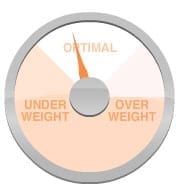BMI vs. Body Fat Percentage
BMI and body fat percentage are weight-loss terms thrown around with little explanation, so if you’re confused about what they mean or which you should pay more attention to, you’re not alone. Here’s a brief primer to help.
BMI stands for Body Mass Index. It’s a simple measure of the weight of a person scaled according to their height. You can follow these steps to determine your BMI:
Multiply your weight in pounds by 703.
Divide that answer by your height in inches.
Divide that answer by your height in inches again.
A healthy BMI is between 18.5 and 24.9.
Body fat percentage is the weight of a person’s fat divided by the person’s weight. It lets you see how much of your body is made up of fat, and how much is bone, muscle, blood, and organs. There are several ways to calculate your percentage. Your skin folds can be gently pinched with calipers, some high-tech scales can measure body fat, and there’s also underwater weighing. Many people get their body fat percentage measured if they are into sports or trying to measure their progress while losing weight. Fit women should have 21 to 24 percent body fat. Female athletes have between 14 and 20 percent.
To find out which one you should be concerned with read more.

Body fat percentage is a much more accurate measurement in determining if you are healthy. BMI doesn’t take into consideration how much of your weight is muscle and bone and how much of it is fat. So that means a person can have a healthy BMI, but still carry weight in their belly, which can increase their risk for heart disease. So if you’re trying to lose weight, or just wondering if your current weight is healthy. It’s worth seeing one of our weight loss experts to have your body fat percentage measured.





